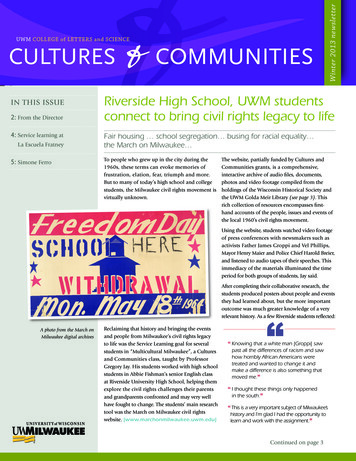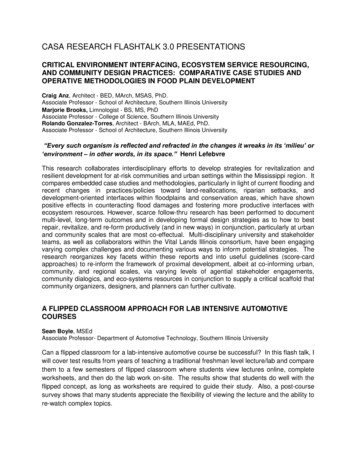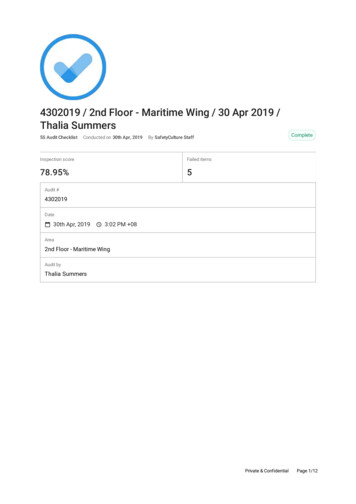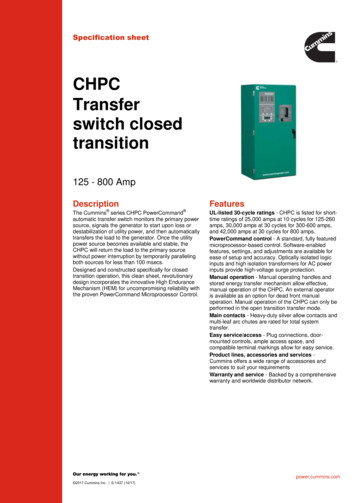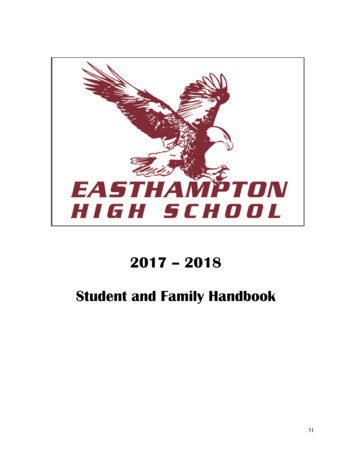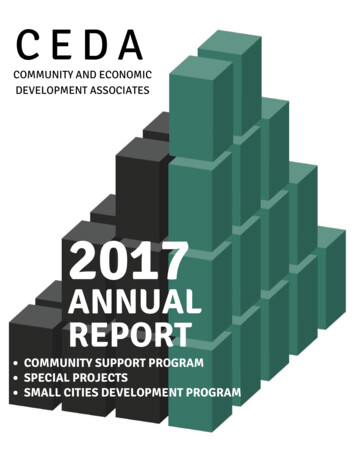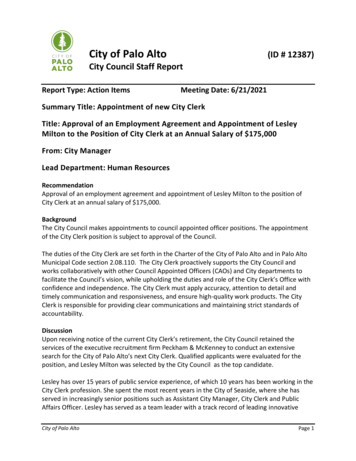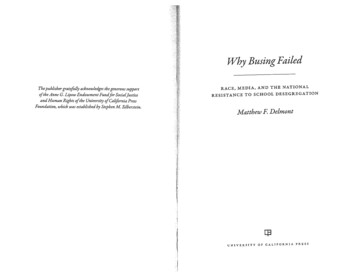
Transcription
IIWhy Busing FailedThe publisher gratefully acknowledges the generous supportoftheAnne G LipowEndowmentFundforSoczalJustzceand Human Rights ofthe University ofCalifornia PressFoundation, which was established by Stephen M SilbersteinRACE, MEDIA, AND THE NATIONALRESISTANCE TO SCHOOL DESEGREGATIONMatthew F. DelmontmUNIVERSITY OF CALIFORNIA PRESS
CONEThe Origins of ff4ntibusing”PoliticsFROM NEW YORK PROTESTS TOTHE CIVIL RIGHTS ACTThere is a pressing need for a liberalism in the North that is trulyliberal, that firmly believes in integration in its own communityas well as in the deep South—DR MARTIN LUTHER KING JR ,speakzngto U banLeagueofNew York City, spdoI do not blame the two distinguished Senators from New York,for they desire to protect New York City, as well as Chicago,Detroit, and similar areasIn my opinion the two Senatorsfrom New York arc, at heart, pretty good segregationists, butthe conditions in their State are different from the conditionsIn ours—MISSISSIPPI SENATORJAMES 0 LASTLAND, 1964over ten thousand white parentswalked from the Board of Education Building in Brooklyn to city hail inManhattan to protest against school desegregation in New York City.Carrying signs reading, “We oppose voluntary transfers,” “Keep our childrenin neighborhood schools,” “I will not put my children on a bus,” and “Wewill not be bused,” the marchers called their coalition of local organizations“Parents and Taxpayers.” They hoped to persuade the school board to abandon a school pairing plan that called for students to be transferred betweenpredominantly black and Puerto Rican schools and white schools. “Most ofthe demonstrators were taking their case into the streets for the first time,”the New York Times reported, noting that more than 70 percent of the demonstrators were women “For every mother who’s here, theie’s another onesitting at home with both her children, wishing she could be here,” said JoanAdabo, a mother from Jackson Heights, Queens.2 While the protestorssought to influence policy at the city level, television news captured the scopeON A SNOWY MARCH DAY ifl 1964,a:
FIGURE j. “Fifteen thousand white mothers” march across Brooklyn Bridge to protest“busing.” NBCNews, March 12 5964.of the march for a national audience. On NBC and ABC, rooftop camerashots showed a long line of protestors snaking through the wet streets of thecity, while another camera angle depicted marchers, ten abreast, emergingfrom the fog as they crossed the Brooklyn Bridge. A street-level shot panneddown to capture the marchers’ reflection in the curbside puddles, an artisticimage emphasizing that the protestors braved inclement weather to be heardand seen. Television news, as well as newspaper coverage and photographs,gave the protestors national visibility. One mother spoke franlcly to an NBCreporter about why Parents and Taxpayers opted for a public protest march:“We feel like we can prove as much as our opponents to use the same tactics.We have as much right as they do. These are our civil rights and we’re takingadvantage of them.”3The white protestors were borrowing tactics from the African Americanand Puerto Rican protestors in New York who organized a school boycott amonth earlier that kept over 460,000 students out of school to demand thatthe school board create a plan for desegregation. This pro-desegregation boycott was, in 1964, the largest civil rights demonstration in the history of theUnited States (bigger than the 1963 March on Washington), but the event is24-THE ORIGINS OF “ANTIBUSING” poLiTIcsFIGURE’. Awhite mother explains to a televisionjournalist, “These are our civil rights andwere taking advantage of them,” NBCNews, March ii. 1964.largely absent from histories of civil rights. The New York Times, whichinsisted that there was “no official segregation in the city,” criticized the boycott as “misguided.”4 Given this climate, New York’s civil rights activistsrecognized that the white protestors, while much fewer in number, wouldcommand much more attention from politicians. Civil rights veteran BayardRustin, recruited by Reverend Milton Galamison to organize the prodesegregation boycott, planned a second rally at city hall in response to thewhite parents’ march and said, “‘We will be successful if we can top the antiintegration people by one person11 be happy with 35,000 and oneNegroes, Puerto Ricans, and whites.”5 Doris Innis, a member of Harlem’sCongress of Racial Equality (CORE), later reflected, “When ro,ooo Queenswhite mothers showed up to picket city hall against integration, it was obvious we had to look for other solutions.”4These civil rights activists understood that the white “antibusing” marchers conveyed a powerful message visually and rhetorically. By 1964, the publicprotest march was a tactic closely identified with African Americancivil rights demonstrators. This made the white protestors particularlyTHE ORIGINS OF “ANTIBUSING” POLITIcS 25
rnewsworthy, because they offered television and print reporters a new angleon a familiar storyline. The newness of the white protest march also helpedemphasize the view that white citizens were entering the school fight for thefirst time, after being pushed too far by school board officials. In reality,school officials and politicians structured housing and school policies aroundthe expectations of white citizens. What these white “antibusing” marcherswere making public was their fear and frustration that this settled expectation was being disturbed.7By calling themselves Parents and Taxpayers, these white protestors madean implicit claim that they occupied a higher level ofcitizenship than black andPuerto Rican New Yorkers, who were also parents and taxpayers. Parents andTaxpayers advanced a similar argument to the hundreds of segregationists inthe South and North who, in the years after the Brown decision, wrote to theSupreme Court to complain that the court was violating their rights as taxpayers.8 The news media and politicians paid special attention to Parents andTaxpayers because they were white, while also affirming the group’s assertionthat their resistance to “busing” for school desegregation was about their rightsas parents, taxpayers, or homeowners, not about race. The simultaneous assertion and disavowal of white political power made it difficult for civil rightsadvocates to counter Parents and Taxpayers and similar “antibusing” groups.Perhaps no one took more notice of the white “antibusing” march than thelegislators who were debating the Civil Rights Act in the spring of 1964,where several United States senators mentioned the New York protest.Senator Absalom Robertson of Virginia read to his colleagues directly fromthe news ticker the day of the protest: “Nearly 15,000 parents opposed toplanned busing of their children for public school integration descended oncity hall today in the largest civil demonstration there in years.”9 Later inMarch, Louisiana’s Russell Long said to Indiana’s Birch Bayh, “I presume theSenator noticed that on a cold, snowy day in New York City 25,000 whitemothers got out and protested. I have heard that haifa million whites havejoined in a counter protest to the mobs marching and taking over. It couldhappen even in Indiana.”0 South Carolina senator Strom Thurmondreturned to this talking point in April: “In New York, where students were‘bused’ around, such a howl went up that 1 ,ooo people assembled in protestagainst the practice.”1’ “Fifteen thousand white mothers,” Georgia’s RichardRussell reiterated in June, “walked in the snow to protest any action tocorrect {raciaij imbalance by the assignment of children to schools outsidetheir residential areas.”12z6‘THE ORIGINS OF “ANTIBUSING” POLITICS . The white New Yorkers who protested against “busing” drew the attention ofUnited States congressmen andwere mentioned repeatedly in the debates over the I9 4 CivilRightsAct.ABCNews, March ,,., 1964.FIGUREFor southern senators who opposed the Civil Rights Act, the white parents’ protests against school desegregation in New York highlighted whatthey saw as the hypocrisy of the Civil Rights Act’s different treatment ofschool segregation in different regions. In addition to recognizing NewYork’s standing as a cosmopolitan city and international media hub, southern senators stressed the New York protests because U.S. congressmanEmanuel Celler, who represented Brooklyn, had played an important role indrafting the legislation and shepherding it through the House ofRepresentatives. Celler, as the southern senators repeatedly pointed out,oversaw the bill as one amendment stripped federal power to investigate andremedy “racially imbalanced” schools and another amendment drew a linebetween desegregation of schools in the South (“Desegregation’ means theassignment of students to public schools and within such schools withoutregard to their race, color, religion, or national origin”) and desegregation ofso-called de facto segregated schools (“Desegregation’ shall not meanthe assignment of students to public schools in order to overcome racialTHE ORIGINS OF ‘ANTIBUSING” POLITICS‘27
imbalance”). Illinois senator Everett Dirksen and Montana senator MikeMansfield successfully proposed another “antibusing” amendment to TitleIV, section 407: “Nothing herein shall empower any official or court of theUnited States to issue any order seeking to achieve a racial balance in anyschool by requiring the transportation ofpupils or students from one schoolto another or one school district to another in order to achieve such racialbalance, or otherwise enlarge the existing power of the court to insure compliance with constitutional standards.”II Regarding this amendment,Mississippi’s James Eastland argued, “It appears that the draftsmen of theDirksen Mansfie1d substitute are so zealous to protect the States of NewYork, Illinois, Indiana, Ohio, Pennsylvania, Michigan, Missouri, andCalifornia, where de facto segregation is now such an important factor inlife, that they go so far as to deny the court itself the power to enlarge itsexisting decisions regarding the achievement of racial imbalance.””While they vehemently opposed the Civil Rights Act, these southernpoliticians saw clearly that the legislation’s “racial imbalance” loophole wouldallow school segregation to exist and expand in northern cities like NewYork, Chicago, and Detroit. For these southern politicians, the “15,000 whitemothers” were a symbol of how resistance to school desegregation in theNorth was accorded more political respect than similar efforts in the South.Seeing the white parent protests against “busing” as a “white backlash” tocivil rights, as the news media and scholars would later describe them,obscures the fact that these protests encouraged northern congressmen toexempt northern schools from the Civil Rights Act’s desegregationprovisions.This chapter examines how New York emerged as the focal point for thebattle over “busing” for school desegregation in the late 1950s and early 1960s,how “busing” developed as shorthand for politicians and parents to describeand oppose school desegregation in polite terms that distinguished themfrom the South, and how protests in New York shaped the wording of theCivil Rights Act. These early demonstrations against school desegregation inthe North offer an example of how local protests worked their way intonational debates and how, in turn, the resulting national policies shapedwhat kinds of changes were possible at the local level. These early “busing”protests and the resulting “antibusing” provision in the Civil Rights Actlimited the federal authority and political will to uproot school segregationin the North, and encouraged local, state, and national politicians to take up“busing” as a way to oppose civil rights. At the same time, early “busing”-FIIIIIprotests emboldened northern school boards to delay taking action to addressschool segregation. “Fifteen thousand white mothers” marched in New Yorka decade before Boston’s “busing crisis” garnered national attention, andthese early “busing” protests help explain both why Boston and other northern cities were able to postpone desegregating until ordered to do so by afederal court and why “busing” resonated so powerfully as a way to opposeschool desegregation. Taking a long view of the “busing” battles makes clearthe important role that anticipation and fear played in motivating oppositionto “busing.” White parents in New York and elsewhere organized to stop“busing” even before school boards or courts ordered that buses be used forschool desegregation and despite the fact that most cities had used buses tomaintain segregated schools. News media coverage of “busing” protests andplans played an important role in fostering this anticipation and fear.Desegregation plans designed for a handful of schools in two neighborhoodscould become citywide stories via newspapers, or national stories via magazines or television broadcasts. Parents in Seattle, Pontiac, and Los Angeles,like the senators in Washington, DC, watched and read about the “fifteenthousand white mothers” protesting “busing” in New York, and this newscontributed to existing local fears that “busing” might soon come to theircities. The white parents who took to the streets to protest school desegregation on a wet and cold day in March 1964 walked less than three miles, buttheir protest rippled across the country, and their opinions shaped civil rightsfor years to come.NEW YORK AFTER BROWN V BOARDIn New York City had the nation’s largest black population. NewYork’s black population had grown from 6o,ooo (under z percent of the totalcity population) to 750,000 (over 9 percent of the total city population) inthe prior five decades, as migrants from southern states and immigrants fromthe Caribbean joined African Americans who had lived in the city for generations.15 Significant black neighborhoods developed in Harlem, BedfordStuyvesant, and Brownsville, with people drawn by the vibrant cultural lifein these areas but also restricted by tacially discriminatory housing policiesand a lack of affordable housing in other parts of the city. ‘The majority ofblack students in New York attended segregated schools, but school officialsmaintained they were not to blame for this situation. “We did not provideTHE ORIGINS OF “ANTIBUSING’ POLITIcSTHE ORIGINS OF ‘ANTIBUSING” POLITICS 29
rHarlem with segregation,” insisted New York City school superintendentWilliam Jansen in 1954. “We have natural segregation here—it’s accidental.”16 Counter to Jansen’s suggestion, in New York as in other northern cities, school zoning policies worked in concert with housing discrimination tosegregate schools.17 Black parents and their white allies had protested theNew York schools in the twenty years before Brown, calling for equal education, an end to teachers’ corporal punishment of students, and removal oftextbooks with racist text and imagery.Ella Baker and Dr. Kenneth Clark, two of the most important AfricanAmerican thinkers and activists in the twentieth century, played central rolesin pushing for educational equality in New York. Baker, best known for hergrassroots organizing in the South for the Southern Christian LeadershipConference (SCLC) and Student Nonviolent Coordinating Committee(SNCC), had lived in New York City since 19z7. Baker traveled across thecountry in the 19405 organizing black communities as the director ofbranches of the National Association for the Advancement of ColoredPeople (NAACP), and served as the president of the New York NAACP inthe early 19505. Baker grew frustrated both by the poor condition of education for black students in New York and the NAACP’s reluctance to prioritize racial discrimination in New York and other northern cities. “They werealways talking about the poor people down South,” Baker later recalled. “Andso the question was, what do you do about the poor children right here?”18Kenneth Clark, famed for the doll experiments that would be cited in theBrown case, was also well aware of the racism and educational inequalityblack children faced, having founded the Northside Center for ChildDevelopment with his wife Dr. Mamie Clark to provide mental health careto Harlem’s children.” In the summer of I95 ., Baker and the Clarks organized meetings of black civic leaders and parents at the Clarks’ suburban homein Hastings-on-the-Hudson to discuss educational issues in the city. The following summer the ad hoc group formally became the Committee on NewYork Public Schools, with Kenneth Clark serving as chairman and Bakerleading the organizing effort. This committee was the foundation for theIntergroup Committee on New York’s Public Schools, an interracial coalition of twenty-eight social, welfare, civic, labor, and religious organizations.Formed in April 1954. the Intergroup Committee included Clark as chairman and Baker on the steering committee.In the months before the Brown decision, Clark and Baker worked tomake school segregation in New York an issue that school officials and politicians could no longer ignore. In a February 1954 speech at the Urban League’sNegro History Week dinner, Clark surveyed the problems of gerrymanderedschool zones and overcrowded and deteriorating black schools, and called onthe board of education to study the conditions of the city’s public schools andracially segregated schools “where they exist in fact, but not by law.”2 Clarkrepeated this call at the Intergroup Committee’s April 1954 conference onNew York City’s Public Schools and gained the endorsement of over fortyorganizations that attended, including the United Parents Associationsof New York City, the NAACP, and the Urban League.2’ New YorkSuperintendent William Jansen strongly disagreed with Clark’s statements,and he tasked his assistant superintendents with providing evidence to refuteClark’s assertions.22 The U.S. Supreme Court’s May 1954 rulingin Brown v.Board of Education, which held that state school segregation laws wereunconstitutional, buoyed Clark and the Intergroup Committee, as did theimportant role the landmark case assigned to Clark’s research on the negativepsychological impact of school segregation on black children. Facing localand national pressure, Arthur Levitt, the president of the board of education,asked the Public Education Association (PEA) to “test by impartial inquirythe validity of the appellation ‘Jim Crow,” an announcement that receivedfront-page coverage in the New York Times.23 In other words, New York’sschool officials praised the Brown decision but wondered if it appliedto them.The New York Amsterdam News, one of the city’s leading black newspapers, continued to press the issue in the summer and fall of 3954, encouragingthe PEA to conduct a “real study and not a whitewash” and reminding schoolofficials that they were “duty bound to see to it that educational services andfacilities in no community fall below those in any other community.”24 TheAmsterdam News also ran an editorial cartoon titled “Siamese Twins” thatfeatured two figures wearing academic caps and gowns, joined at the hip,labeled “New York City’s School System” and “The South’s Jimcro [sic] tradition.”25 To counter what he called the Amsterdam News’ “calculated campaign of opposition to the Board of Education,” the school board’s publicrelations assistant advised jansen to make a “good faith” effort to implementthe PEA report’s recommendations and establish a Commission onIntegration, made up of board members and civic leaders. Accompanying theformation of the Commission on Integration in December 1954, the boardof education’ passed a resolution that took note of the Supreme Court’sBrown ruling against segregated schools, and tasked the commission withTHE ORIGINS OF “ANTIBUSING’ POLITICS30‘THE ORIGINS OF “ANTIBUSING” POLITICS 31
recommending “whatever further action is necessary to come closer to theideal, viz., the racially integrated school.”26 ‘While this amounted to littlemore than a promise for additional study, Clark praised the move as a necessary starting point.Thanks to regular newspaper coverage, the debate over school segregationin the months before and after the Brown decision reached a large audienceamong white New Yorkers. June Shagaloff, who had worked with Clark toconduct historical and social science research for the Brown case and later ledNAACP efforts to challenge school segregation outside the South, recalledthat “the word ‘desegregation’ was a new word” for white citizens, schoolofficials, and the white press. “These were issues that were new to them.”27Clark also sawpublic awareness as the first goal ofthe Intergroup Committee’swork: “To focus public attention on the fact of clefacto segregated schools inNew York City [was] an important goal, because we felt that the people ofNew York City were not aware of public school segregation as an issue whichfaced the city itself.”28For their part, school officials remained cautious about the legal ramifications of school segregation receiving wider attention. Following a pressrelease on the PEA’s school study, schools superintendent Jansen wrote toRose Shapiro, who was directing the zoning portion of the PEA’s report, toask her to avoid using segregation in relation to New York schools. “The useof the word ‘segregation’ in releases is always unfortunate,” Jensen wrote.“Segregation means a deliberate act of separating. In Kenneth Clark’s allegation, he alleges that we deliberately segregate children which is false. Thestatement of principles also implies that racial segregation exists in ourschools. There is no justification for charging this to our schools.”29 Manyother northern school officials, politicians, and parents shared Jansen’s distaste for the word segregation, preferring words like separation and racialimbalance. These word choices emphasized that northern-style school segregation was innocent, natural, and lawful, while perpetuating the myth thatracism structured spaces and opportunities in the South but not the North.The PEA report, released in October 1955, found that 71 percent of elementary schools enrolled either 90 percent or more black and Puerto Ricanstudents or over 90 percent white students. ‘While describing this as “a stateof affairs which we should all deplore,” the report also insisted that this issue“cannot be placed at the doorstep of the Board of Education” and drew a cleardistinction between “separation” and “segregation”: “Many conditions conspire to promote such a separation of children in schools but in a strictly legal. .THE ORIGINS OF ‘ANTIBUSING’ POLITICssense of the word there is no such thing as segregation in the school systemof New York City.”3 While the report did not make a formal recommendation regarding integration it recommended that information on school district lines be made publicly accessible and that “whenever a superintendentcan further integration by drawing district lines he should so do.”3’Despite these modest recommendations, the report became a subject ofcontroversy among white parents and teachers, and it was here that the termbusing first appeared in news reports, public hearings, and rumors as a way todescribe and discourage school desegregation. The Wall Street Journal wasthe first major newspaper to sound alarms over “busing” by overstating thescale of the school board’s zoning plan. After describing two hundred blackchildren who were bused to PS 93 in the Bronx, journalist Peter Bart warned,“This is only the beginning. A ‘master plan’ to speed up the integration process for New York’s 925,000 public school pupils has been drawn up by thesubcommittee on zoning of the Board’s Commission on Integration. Ifapproved, the plan will take effect next September. It proposes extensive useof city-financed buses to create racially balanced schools and suggests thatracial integration should be the sole objective of school zoning.” Describingwhat he called an “enforced mass migration of school children,” Bart alertedreaders that white children were already being “bused”: “Hundreds of NewYork students are already criss-crossing the city by bus and subway to schoolsfar from home. Not only are children from Negro sections of Harlemtraveling to hitherto all-white schools; in some instances, white pupils arecrossing regular school zones to enter all-Negro schools.”32 The AssociatedPress also picked up the story in spring 1957, noting that “fivewords: ‘Selectiveuse of bus transportation” had sparked “fiery protests” in New York. Whilethe AP’s report was less alarmist than the Wall StreetJourna4 the AP storymade clear the national implications of the New York case: “The nation’sbiggest city has gone beyond legal requirements that all races be admitted toschools on an equal basis, and is taking additional direct action to fosterinterracial student bodies. The move could set a trend.”33 In addition to thesenews reports, white residents in East Queens and other neighborhoodsreceived reprints, sent anonymously, of pamphlets such as “The Ugly Truthabout the NAACP” and “The Red Hand in New York Schools,” whichattacked the NAACP and school integration as communist.34 These publications stoked existing fears in the white community and fueled rumors thatthe school board was calling for extensive cross-city “busing” for schooldesegregation.THE ORIGINS OF ‘ANTIBUSING’ POLITICS‘33
In their letters to the board ofeducation, many parents were unambiguousin listing the reasons they feared and opposed school desegregation. Onefather asked, “Do you gentleman honestly believe that you can then ship ourchildren back to some slum schoolto spend their lunch hours in streetsthat are civic cesspools. without a fight on your hands?’35 An “Irate Parent”framed opposition in the language of homeowners’ rights: “Do you thinkthat I and so many others like me moved to this neighborhood so that our[children) would be uprooted and have to travel to a place at an uncomfortable distance!”36 The racism in other letters was explicit. “The Negro isemerging from ignorance, savagery, disease and total lack of any culture,” oneletter stated. “Is it necessary to foist the Negro on the ‘White Americans forfair play?”37 Another letter simply said, “We don’t want our children integrated with Blacks.”38 These letters offer a snapshot of the feelings that underscored opposition to school desegregation and suggest how, in the privacy ofhomes and neighborhood spaces, such sentiments propelled rumors that“busing” was imminent.Well aware of the growing public sentiment on desegregation,Superintendent Jensen and his colleagues held public meetings in whiteneighborhoods and issued statements to newspapers in an attempt to quellthese widespread “busing” rumors. “We have no intention whatsoever oflong-distance bussing or bussing of children simply because of their color,”Jansen told the New York Times in response to a report on the more than twothousand letters the board of education had received criticizing the integration plan.39 “These rumors are completely false,”Jansen later said to a gathering of seven hundred parents, teachers, and principals in Queens. “No suchaction is planned.’4 True to his word, Jansen’s report on zoning, issued inJuly 2957, reflected the concerns ofparents who had rallied against the potential of “busing.” The report identified “the neighborhood school concept” asthe heart of the school’s zoning policy and stated, “Pupils should not betransported by bus from one school to another solely for the purpose of integration.”Jensen also reasserted that the issue of school segregation was largelybeyond the control of the school board: “The homogenous character of someschool neighborhoods is an effect of segregated residential patterns, a condition which the schools cannot deal with directly.’4’ While Jansen’s reportmay have placated the desires ofwhite parents and teachers, it drew the ire ofCommission on Integration members like Ella Baker who worked on thepreliminary zoning report. “There is a unanimous revolt of the IntegrationCommission against Dr. Jansen’s position,” Kenneth Clark told the New. .34THE ORIGINS OF ‘ANTIBUsING’ POLITIcsIYork Times. “We feel that the Superintendent is deliberately confusing,delaying, distorting, and sidetracking the reports of our commission. He isno more likely to implement our reports than he was two years ago.Thepeople of the city will not tolerate this sabotage.’42Clark was frustrated not only that Jansen had delayed and watered downthe zoning report but that “busing” came to dominate the public discussionover school desegregation in New York. Clark argued that the Commissionon Integration’s zoning report. .became the basis for a tremendous amount of local and national distortion.Before we knew it, it was rumored that this subcommittee was recommending that children from all white neighborhoods should be taken by bus toschools in the heart of Negro ghettoes. It was even stated children would bebrought from Staten Island to attend schools in Harlem. Those of us who hadworked for two years with the Commission on Integration, and who were inconstant touch with the activities of each subcommittee, were first shockedand then alarmed at what we were reading in some areas of the press. It wasnot long before we became aware of the fact that these distortions and rumorswere not accidental. They seemed to have been planted and they received widecirculation throughout the city and the nation. Systematic study of thereport on zoning revealed that at no place in the report is there a suggestion that young children be “bussed” any considerable distance in order tofacilitate integration. I should like to add one other fact not found inthis report: namely, there were until last year instances in which buses wereused by the Board of Education to transport white children away from a nearNegro school to a more distant non-Negro sch
obscures the fact that these protests encouraged northern congressmen to exempt northern schools from the Civil Rights Act's desegregation provisions. This chapter examines how New York emerged as the focal point for the battle over "busing" for school desegregation in the late 1950s and early 1960s,
